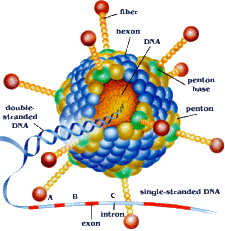It's not always influenza that kills, Part 5
 Over the weekend, a fascinating story crept up on us. Down in the Southern Hemisphere earlier this month (April 9), a Chinese fishing vessel was surrounded by elements of the Peruvian Navy. From news and Promed reports, two Chinese sailors died of a "strange mutant virus." This virus has apparently proven itself to be Adenovirus, and i am betting something along the lines of Ad14.
Over the weekend, a fascinating story crept up on us. Down in the Southern Hemisphere earlier this month (April 9), a Chinese fishing vessel was surrounded by elements of the Peruvian Navy. From news and Promed reports, two Chinese sailors died of a "strange mutant virus." This virus has apparently proven itself to be Adenovirus, and i am betting something along the lines of Ad14.
Veteran readers of this Blogsite should be lay experts on Adenovirus by now. With more than 50 substrains, Adenovirus has been getting a lot of press lately. Adenovirus is a culprit for "ILI," or Influenza-Like Illness. It is also a culprit for "stomach flu," a term we all know is misleading and inaccurate but still out there, helped along by the medical community itself.
There may be "good Adenovirus." Genetically-rendered Adenovirus promises to be the solution to everything from HIV/AIDS to bird flu itself, specifically by using Adenovirus as the agent to allow the respective vaccines to work their intended magic.
Whenever I read about adenovirus being used in a vaccine, I can't help but think of the new Hollywood "imagining" of Richard Matheson's classic novel I Am Legend. There is still no "true" and faithful film adaptation of the novel, but this is about as close as we're going to get. Anyway, in the Will Smith movie, an uncredited Emma Thompson proclaims that a vaccine for cancer has been developed, using genetically-rendered measles virus.
Weeks later, the world has descended into chaos and murder.
Anyway, back to the Peruvian story. This was picked up by Mike Coston in his Avian Flu Diary blog, and then Crof ran with it over at H5N1. A short excerpt from Mike's posting of the story, translated from Flu Wiki:
This has raised the epidemic alarms. The health authorities of the country have imposed a quarantine and medical monitoring on 30 medical professionals and personal of the Navy that went to the aid of the fishing boat as a precautionary measurement. Until now none of them presents/displays symptoms of the disease.
Meanwhile, the fishing ship "Chan An 168" and its 22 surviving crew remain in quarantine, in an isolated zone to eight miles (10 kilometers approximately) off the port of the Callao, until it is determined how they acquired the disease. Patrol boats of Navy military watch that nobody boards nor leaves the boat.
DEADLY VÍRUS
The medical examinations have determined that eight of the other Chinese crew have the deadly virus, although they have not developed [symptoms]. Cook Jiang Dexin (40) and the crew member Che Caiqiang (38) of this boat died April 9th, after presenting/displaying high fevers during hours. No medicine could delay the advance of the disease.
The experts of the Legal Medicine Institute of the Public Ministry have determined that the cause of the death was "adenovirus" that has become extremely deadly.
The only Adenovirus that I can think of that causes respiratory symptoms -- and death -- on par with influenza is Ad14. Search for my previous blogs on Ad14 for background. The Case Fatality Rate for hospitalized Ad14 victims in the Pacific northwest was over 20%, based on a medical study. For a refresh, here are some highlights from a news story about Ad14, published back in October, 2007 and also available on this Blogsite.
I have repeatedly called for a cheap, reliable Adenovirus 14 test, and for disclosure and record-keeping of this disease. If it was enough to kill two Chinese sailors, cause the quarantine of some 30 Peruvian military personnel and create a public relations fiasco for the Peruvian government, it is serious enough to be documented.First encountered in 2005 in Oregon, the viral pneumonia frequently leads to hospitalization and has a 20% fatality rate, (bold mine) Paul Lewis, M.D., of the Oregon State Public Health Department, said at the Infectious Diseases Society of America meeting.
Recognition of the adenoviral pneumonia began with four patients hospitalized simultaneously at a Portland hospital. Upon comparing notes with physicians at area hospitals, Dr. Lewis and colleagues "almost fell out of our chairs because every hospital we called had recent severe and fatal cases of adenovirus disease."
Investigators followed up the informal communication with a systematic review of all cases of adenovirus disease identified by Oregon clinical laboratories from November 2006 to April 2007. Six months of active surveillance revealed what appeared to be a winter-spring predominant adenovirus disease, as the number of reported cases increased from January through April.
Isolates from the sickest patients were sent to the CDC, which found that almost all the cases involved adenovirus 14, a serotype identified more than 50 years ago but rarely detected since then and never in association with outbreaks.
Dr. Lewis and colleagues at the state health department reviewed analyzed specimens dating back to 1993 and found a few cases of adenoviral disease almost every year. Beginning in 2005 adenovirus 14 was the predominant serotype identified.Comparison of 31 patients with adenovirus 14 disease and 14 patients with other adenovirus serotypes showed that adenovirus 14 tended to infect older men (median age 52.9), and almost half the cases involved smokers. Most strikingly, adenovirus 14 was associated with a hospitalization odds ratio of 15.9 compared with other adenovirus serotypes.
"This came out of nowhere in 2005 in Oregon," said Dr. Lewis. Acknowledging that almost all of the cases have involved severe illness, he agreed that the scope of the problem could be much larger and involve a broader spectrum of illness severity.

Reader Comments